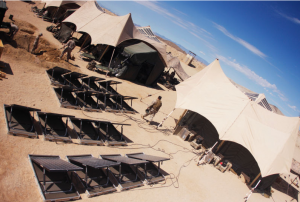With Earth Day coming up in April, a lot of focus is put on green initiatives, and how various fields of manufacturing are planning to further their push towards a more environmentally-sound and responsible existence. Few fields have pushed harder towards greening their processes and industry than medical and military.
Medical and military look to green their industries for differing reasons. In the military field, much of the drive comes from the desire to be mobile and to save lives. Refueling vehicles that are extremely dependent on oil leaves troops vulnerable to enemy attack, so converting fuel operations to renewables can reduce the amount of time troops spend in harm’s way. Additionally, utilizing solar panels allows for fast set-up of bases of operations, as well easy mobility of bases, allowing better movement and providing for different tactics.
As Reuters notes, this isn’t exactly new – between 2011 and 2015, military renewable energy projects nearly tripled. The reasoning behind it is that U.S. bases are being set up to operate independent of the public grid, using solar power and on-site generation. In the case of a natural disaster or attack, this could leave the important bases operating even if the public grid is down, allowing for response and recovery.
In comparison, the medical field is stationary, so it doesn’t need to go green to improve mobility. While there are a number of green initiatives coming, with suggestions such as greener waste disposal methods and water conservation high on the list, none is greater than the push to consume less energy or more responsibly-sourced energy. With energy making up an approximate 1%-3% of a typical hospital’s operating budget, cutting that back can make a huge dent.
Numerous hospitals have already tried reduction and succeeded – when Greenwich Hospital in Connecticut reprogrammed its heating and cooling plants, updated its light bulbs, and reengineered the air handling system, it saw a reduction in energy use by 35%, saving over $300,000 per year. The energy savings allowed the hospital to recoup its capital investment in the projects within six months – a shining example of how going green is not only great for the environment but can be great for the bottom line of a company. Many other hospitals and systems have, or are in the process of making a move to greener energy – University of Maryland Medical Center, Stony Brook University Hospital, and the Philadelphia College of Osteopathic Medicine are just some of the major cases.
At Connectronics, we focus on producing connectors and interconnect equipment for use with a wide variety of systems, including the latest in renewable and alternative energy sources. Keep up with all we are doing in the connector field by connecting with us yourself, through LinkedIn, Twitter, and here at our blog. Our regular updates include insight into our future plans, industry information, and much more.
For further questions on your projects and our products contact us today.







